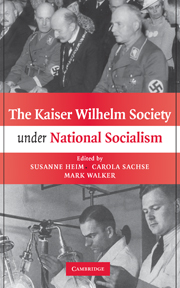Book contents
- Frontmatter
- Contents
- Tables
- Illustrations
- Editors
- Contributors
- Abbreviations
- Archives
- 1 The Kaiser Wilhelm Society under National Socialism
- SECTION I RESEARCH AND PERSONNEL POLICIES
- SECTION II RACIAL RESEARCH
- SECTION III EASTERN RESEARCH, LIVING SPACE, BREEDING RESEARCH
- SECTION IV MILITARY RESEARCH
- SECTION V THE POSTWAR “POLITICS OF THE PAST”
- 15 “Whitewash culture”: How the Kaiser Wilhelm/Max Planck Society Dealt with the Nazi Past
- 16 The Pedecessor: The Uneasy Rapprochement between Carl Neuberg and Adolf Butenandt after 1945
- Bibliography
- Index
15 - “Whitewash culture”: How the Kaiser Wilhelm/Max Planck Society Dealt with the Nazi Past
Published online by Cambridge University Press: 29 July 2009
- Frontmatter
- Contents
- Tables
- Illustrations
- Editors
- Contributors
- Abbreviations
- Archives
- 1 The Kaiser Wilhelm Society under National Socialism
- SECTION I RESEARCH AND PERSONNEL POLICIES
- SECTION II RACIAL RESEARCH
- SECTION III EASTERN RESEARCH, LIVING SPACE, BREEDING RESEARCH
- SECTION IV MILITARY RESEARCH
- SECTION V THE POSTWAR “POLITICS OF THE PAST”
- 15 “Whitewash culture”: How the Kaiser Wilhelm/Max Planck Society Dealt with the Nazi Past
- 16 The Pedecessor: The Uneasy Rapprochement between Carl Neuberg and Adolf Butenandt after 1945
- Bibliography
- Index
Summary
CONSTRUCTED CONTINUITY – MANUFACTURED SUPPRESSION
Contemporary discussion of the “zero hour” (Stunde Null) – sometime between the end of war and monetary reform – was replaced long ago by historiographic discussion of a dominating continuity, especially with regard to West German economic and science elites. On the other hand, in a 1995 article, Mitchell Ash concluded that personal continuity in the scientific community did not happen of its own accord. In fact, it was constructed with persistence and finesse in the course of the denazification of “incriminated” individuals and networks. This chapter will use this thesis to demonstrate that the associated mental procedure – in popular psychology referred to as the “repression” (“Verdrängung”) of participation in National Socialist rule, violence, and crime – was more than just an unconscious psychological process. At the same time, it was a communicative process used by the scientific elites while reconstituting their disciplines and institutions in postwar Germany. As such, it was bound to a manner of discourse that first had to be established, tested, and agreed upon; its message, however, had to be adjusted repeatedly to accommodate the changing political constellations and social contexts of the postwar era. But “repression” was not only a mental but also an active process, when scientific communities unburdened themselves of overly “incriminated” colleagues and tried to drive them out of their circles. That is, “repression” was multifaceted, a carefully and elaborately manufactured product of individuals, institutions, and networks. It was a constitutive element of the construct “continuity.”
- Type
- Chapter
- Information
- The Kaiser Wilhelm Society under National Socialism , pp. 373 - 399Publisher: Cambridge University PressPrint publication year: 2009

